Fish Guide
Falkland's fish and squid fall into three ecological groups: pelagic, benthopelagic and demersal. The differences in the natural behaviour of each group have an effect on the characteristics of the meat that we can expect to experience.
Pelagic: Patagonian Hoki, Southern Blue Whiting, Illex squid
Benthopelagic: Hake, Toothfish, Patagonian Rock Cod, Patagonian squid
Demersal: Kingclip, Red Cod
Pelagic species of Falkland's fish swim thousands of miles throughout the Southern and Atlantic Oceans, a feat of endurance which requires a good supply of energy in the form of oil that is evident in darker fat storing flesh and slightly oily taste while the relatively indolent life of demersal fish produces the brilliantly white and firm chunky flesh that we all, as seafood consumers, enjoy.
- Falklands Hake
- Patagonian Hoki
- Toothfish (Chilean seabass)
- Southern Blue Whiting
- Skates and Rays
- Falklands Kingclip
- Wings, Collars and Cheeks
- Southern Rockcod (Notothenia)
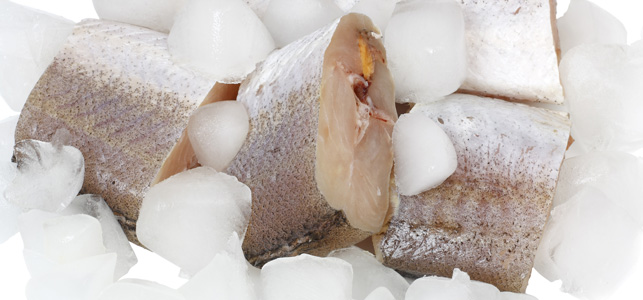
Falklands Hake
Merluccius Hubbsi, M. australis
Hake or Merzula is the fish of choice in Spain and while the flesh structure of South Atlantic Hake is firmer and more resilient than European Hake there is little taste distinction made between the two varieties.
The delicious fulsome meaty flavours and creamy texture that make the fish so popular in the quality conscious markets of Portugal, France and Italy as well as Spain are a characteristic of the species made only more pronounced by the quality of the fishing grounds.
Baby Hake
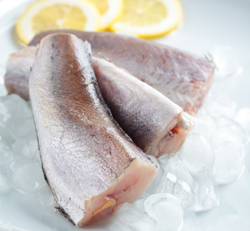
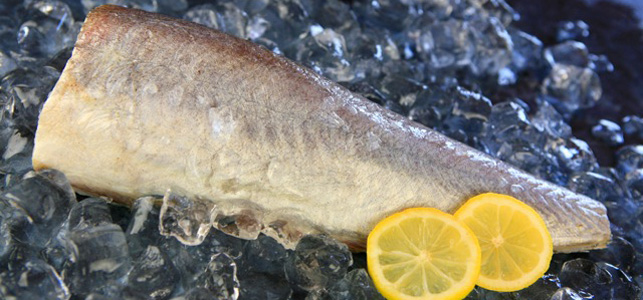
Patagonian Hoki
Macruronus magellanicus
A member of the Hake family, Hoki is widely known as Blue Hake because of the blue-green iridescence of its skin. The flesh yields a firm fillet with chunky flakes and has an intense sweetness. It is known in the trade as a flavoursome and dependable whitefish, with few bones, that works well in a range of dishes. As a good all rounder it has become one of the most popular casual dining fish in the US.

Toothfish (Chilean seabass)
Patagonian Toothfish Dissostichus eleginoides
Antarctic Toothfish Dissostichus mawsoni
Chilean seabass (the market's name for Toothfish) enjoys huge demand from A-list restaurants and retailers. Kilo for kilo this highly prized fish is more valuable than prime fillet steak and its demand has much to do with the flesh's texture which is very different from European seabass. The large densely packed flakes, which is a characteristic shared with Kingclip, produces wonderfully thick and firm user-friendly fillets that are ideal for high heat contact cooking. The high fat content and gleaming white fillet also earn it top position on the order lists of sushi chefs along with other fatty fish such as Yellowtail Kingfish.
This product comes from a fishery which has been independently certified to the MSC's standard for a well-managed and sustainable fishery. www.msc.org - MSC Chain of Custody Code MML-C-1120.
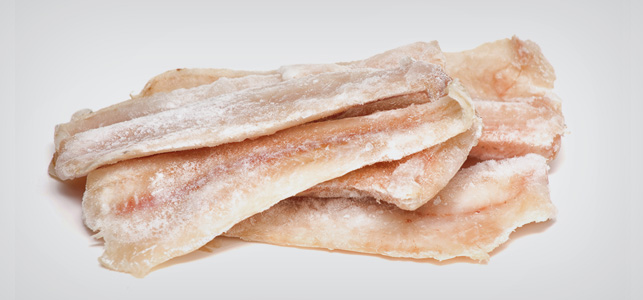
Southern Blue Whiting
Micromesistius australis
The classic choice for the high quality surimi-processing sector along with Alaskan Pollack where it is often blended with crab or lobster meat and sold to prepared food manufacturers and food service operators as the basis for thousands of ready-to-eat meals, seafood snacks and breaded products.
The snow white meat, firm structure and mild taste of this all purpose whitefish also give it broad appeal in the frozen fillet market.
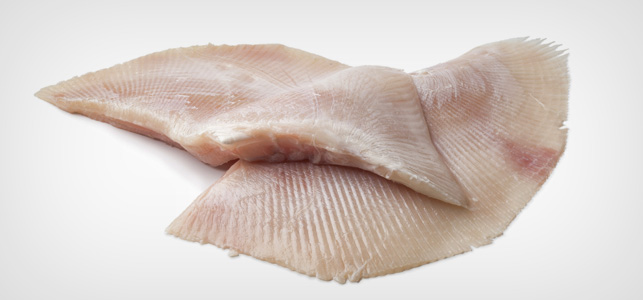
Skates and Rays
Bathyraja griseocauda, B. albomaculata, B. brachyurops, Zearaja chilensis
The standard method of preparing Skate onboard the fishing boat is to cut away the eating parts – the two large fan-like fins that stretch down either side of the body from the head to the tail - and skin them on board. These pre-cut "wings" then only need to be quickly trimmed and portioned in the kitchen before cooking. Falklands skate are relatively small, on average between 40 and 60 cm. The smaller sizes produce great plate-sized wings perfect for serving whole and the larger 500g plus wings are ideal for filleting.
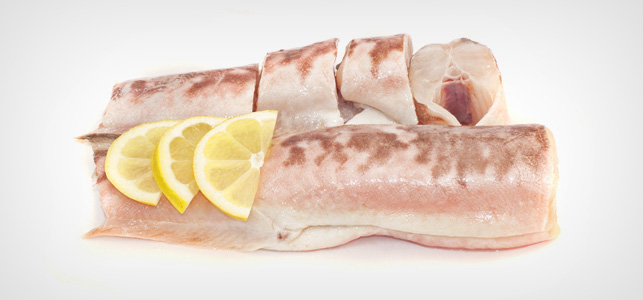
Falklands Kingclip
Genypterus blacodes
Kingclip is another much sought after fish that is popular in the high-end restaurant trade and at home because of its firm and forgiving meat. Its pearly white flesh is silky and has tightly packed large flakes which give a distinctive flavour that is stronger and sweeter than Toothfish. It is a favourite of home cooks as well as chefs who want luxury seafood made simple because it is so easy to prepare. It has a simple bone structure and a firm versatile fillet that can be fried, barbequed, stewed or even overcooked without losing the natural firmness. It is also known as Pink Ling because of its distinctively colourful skin which gives the skin-on fillet a great retail appearance.
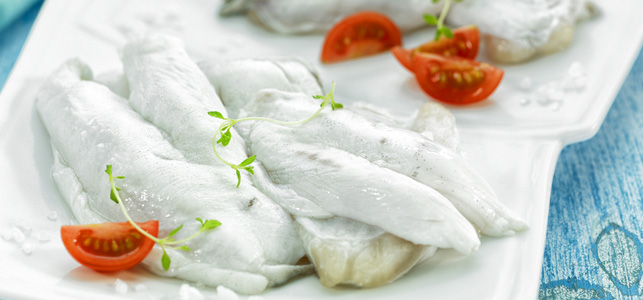
Wings, Collars and Cheeks
Other fish portions processed and frozen at sea
The fish parts that are cut away to produce the trunk (the headless and tail-less body of the fish) can themselves be sources of wonderfully succulent fleshy pieces of meat that are especially popular in roasted seafood dishes that are full of body and flavour.
The "Wings" are portions of meat cut from the fleshy area around the wing-like pectoral fin at the head end of the belly of the fish. Large round-bodied fish such as Kingclip and Hake produce thick chunks of flesh in this area that are pure meat.
On larger fish this pectoral flesh can be separated attached to the meat from the top shoulder and lower breast area to produce a crescent-shaped "collar-cutlet". This thick slice is cut straight through the cross-section of the fish from the edge of the gill cover to the tail-side of the pectoral fin.
Roasted fish heads are an Asian banquet speciality and the best part of the dish, the "pearl" found inside the cheek cavity, is a delicacy often reserved for the guests of honour. To save space these exclusive scallop-like portions are carefully extracted from the fresh fish heads on board the boat, and packed for sale separately.
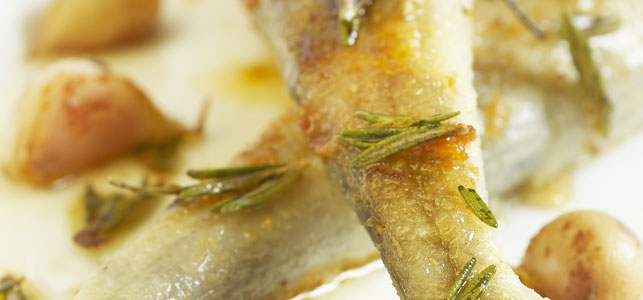
Southern Rockcod (Notothenia)
Patagonotothen ramsayi
Patagonian Rock Cod is a small mineral-packed fish that has rapidly ascended the fish charts as a speciality health food fish in the same league as Antarctic Icefish. It is comparable to Herring in size and bone structure and occupies the same market segment as Mackerel and other small and healthy oily fish species. The retail product is often sold under private delicatessen brands as Trunchi di Cod. The cooked flesh is pale grey with a delicately flaky texture and skin that separates easily. It is a tasty and healthy fish, leaner than Mackerel but with similarly high levels of vitamins and minerals and especially high in protein.
